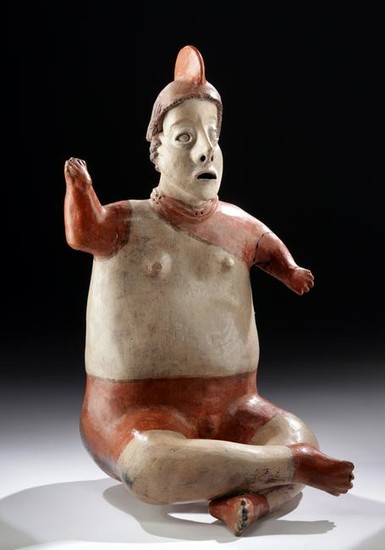Large Nayarit Polychrome Seated Warrior Figure w/ TL
Pre-Columbian, West Mexico, Nayarit, San Sebastian type, ca. 100 BCE to 250 CE. A sizeable polychrome - orange and white with black outlines - seated male warrior figure with legs crossed at the ankles, his right arm raised and his left arm extended outward from his body just a tad. Topped by a crested coiffure or helmet, his cream-hued visage is quite expressive, presenting large almond-shaped eyes, an arched browline, a pronounced nose with delineated nostrils, an open mouth as if speaking, chanting, or singing, nicely contoured facial planes with faint black striations (indicating tattoos or face paint) across the cheeks, and an incised short coiffure. He wears a painted cream shirt having an over the right shoulder strap and cream-hued leg wraps. Otherwise his body is nude, revealing male genitalia. In addition to the head crest, he is bedecked with fancy ear ornaments and a double coiled necklace with partial perforations to decorate it. Size: 10.375" L x 9.625" W x 17.75" H (26.4 cm x 24.4 cm x 45.1 cm)
West Mexican shaft tomb figures like this example derive their names from the central architectural feature that we know of from this culture. Nayarit, located on Mexico's southwest coast, was part of the shaft tomb culture during this time, along with neighbors in nearby Colima and Jalisco. These indigenous peoples would build generally rectangular vertical or near-vertical shafts down from the ground level - usually about 3 to 20 meters deep - through tepetate, the volcanic tuff that makes up the geology of the region, to narrow horizontal tunnels that led to one or more vaulted or rounded burial chambers.
These shafts were almost always dug beneath a dwelling, probably a family home, and were used as family mausoleums, housing the remains of many related individuals. Figures like this one were placed into the tombs; researchers believe that they were placed around the edges facing inward, as if in conversation with the dead. Grouped with other figures, and alongside clay bowls, and boxes, figures like this one were positioned around the body (or bodies), near the skull.
This piece has been tested using thermoluminescence (TL) analysis and has been found to be ancient and of the period stated. A full report will accompany purchase
Provenance: ex-private Howard Rose Gallery, New York, New York, USA; ex-private collection, California, USA; ex-Jim Bodisbaugh collection
All items legal to buy/sell under U.S. Statute covering cultural patrimony Code 2600, CHAPTER 14, and are guaranteed to be as described or your money back.
A Certificate of Authenticity will accompany all winning bids.
We ship worldwide to most countries and handle all shipping in-house for your convenience.
#150158
Condition Report: Repaired from approximately fifteen pieces with restoration over the break lines. Left arm repaired and reattached, break lines visible, two toes reattached with minute losses to tips of fingers and toes. Scattered mineral deposits on the surface.
View it on
Estimate
Time, Location
Auction House
Pre-Columbian, West Mexico, Nayarit, San Sebastian type, ca. 100 BCE to 250 CE. A sizeable polychrome - orange and white with black outlines - seated male warrior figure with legs crossed at the ankles, his right arm raised and his left arm extended outward from his body just a tad. Topped by a crested coiffure or helmet, his cream-hued visage is quite expressive, presenting large almond-shaped eyes, an arched browline, a pronounced nose with delineated nostrils, an open mouth as if speaking, chanting, or singing, nicely contoured facial planes with faint black striations (indicating tattoos or face paint) across the cheeks, and an incised short coiffure. He wears a painted cream shirt having an over the right shoulder strap and cream-hued leg wraps. Otherwise his body is nude, revealing male genitalia. In addition to the head crest, he is bedecked with fancy ear ornaments and a double coiled necklace with partial perforations to decorate it. Size: 10.375" L x 9.625" W x 17.75" H (26.4 cm x 24.4 cm x 45.1 cm)
West Mexican shaft tomb figures like this example derive their names from the central architectural feature that we know of from this culture. Nayarit, located on Mexico's southwest coast, was part of the shaft tomb culture during this time, along with neighbors in nearby Colima and Jalisco. These indigenous peoples would build generally rectangular vertical or near-vertical shafts down from the ground level - usually about 3 to 20 meters deep - through tepetate, the volcanic tuff that makes up the geology of the region, to narrow horizontal tunnels that led to one or more vaulted or rounded burial chambers.
These shafts were almost always dug beneath a dwelling, probably a family home, and were used as family mausoleums, housing the remains of many related individuals. Figures like this one were placed into the tombs; researchers believe that they were placed around the edges facing inward, as if in conversation with the dead. Grouped with other figures, and alongside clay bowls, and boxes, figures like this one were positioned around the body (or bodies), near the skull.
This piece has been tested using thermoluminescence (TL) analysis and has been found to be ancient and of the period stated. A full report will accompany purchase
Provenance: ex-private Howard Rose Gallery, New York, New York, USA; ex-private collection, California, USA; ex-Jim Bodisbaugh collection
All items legal to buy/sell under U.S. Statute covering cultural patrimony Code 2600, CHAPTER 14, and are guaranteed to be as described or your money back.
A Certificate of Authenticity will accompany all winning bids.
We ship worldwide to most countries and handle all shipping in-house for your convenience.
#150158
Condition Report: Repaired from approximately fifteen pieces with restoration over the break lines. Left arm repaired and reattached, break lines visible, two toes reattached with minute losses to tips of fingers and toes. Scattered mineral deposits on the surface.



